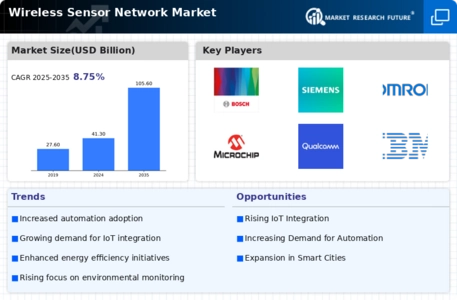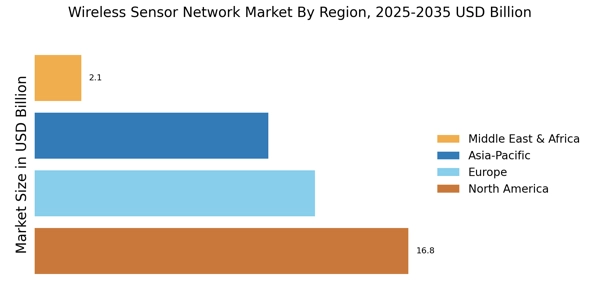Rising Demand for Automation
The Wireless Sensor Network Market is experiencing a notable surge in demand for automation across various sectors. Industries such as manufacturing, agriculture, and healthcare are increasingly adopting wireless sensor networks to enhance operational efficiency and reduce human intervention. This trend is driven by the need for real-time data collection and monitoring, which facilitates informed decision-making. According to recent estimates, the automation sector is projected to grow at a compound annual growth rate of approximately 10% over the next five years. This growth is likely to propel the Wireless Sensor Network Market, as organizations seek to implement advanced technologies that streamline processes and improve productivity.
Advancements in Sensor Technology
Technological advancements in sensor technology are significantly influencing the Wireless Sensor Network Market. Innovations such as miniaturization, improved battery life, and enhanced data transmission capabilities are making wireless sensors more efficient and cost-effective. These advancements enable the deployment of sensors in diverse environments, from remote locations to urban settings. The market for advanced sensors is expected to reach a valuation of several billion dollars by 2026, indicating a robust growth trajectory. As sensor technology continues to evolve, it is likely to drive the expansion of the Wireless Sensor Network Market, providing new opportunities for applications in smart homes, industrial automation, and environmental monitoring.
Expansion of Smart Agriculture Practices
The Wireless Sensor Network Market is benefiting from the expansion of smart agriculture practices. Farmers are increasingly utilizing wireless sensor networks to monitor soil moisture, crop health, and weather conditions, thereby optimizing resource usage and improving yield. This trend is driven by the need for sustainable farming practices and the rising global population, which necessitates increased food production. The smart agriculture market is projected to grow at a compound annual growth rate of over 12% in the coming years, indicating a strong demand for wireless sensor technologies. As agricultural practices evolve, the Wireless Sensor Network Market is likely to see substantial growth, providing innovative solutions to meet the challenges faced by modern agriculture.
Integration with Smart Home Technologies
The integration of wireless sensor networks with smart home technologies is emerging as a significant driver for the Wireless Sensor Network Market. Home automation systems are increasingly incorporating wireless sensors to enhance security, energy management, and overall convenience for users. This trend is fueled by the growing consumer interest in smart home solutions, which are projected to reach a market size of over 100 billion dollars by 2027. As more households adopt smart technologies, the demand for wireless sensor networks is expected to rise, creating new opportunities for innovation and development within the Wireless Sensor Network Market. This integration not only improves user experience but also contributes to energy efficiency and sustainability.
Growing Focus on Environmental Monitoring
The increasing emphasis on environmental monitoring is a key driver for the Wireless Sensor Network Market. Governments and organizations are prioritizing sustainability and environmental protection, leading to the deployment of wireless sensor networks for monitoring air quality, water quality, and other ecological parameters. This trend is supported by regulatory frameworks that mandate environmental assessments and reporting. The market for environmental monitoring solutions is anticipated to grow significantly, with investments in wireless sensor technologies expected to rise. This focus on sustainability not only enhances the capabilities of the Wireless Sensor Network Market but also aligns with global efforts to combat climate change and promote ecological conservation.

















Leave a Comment